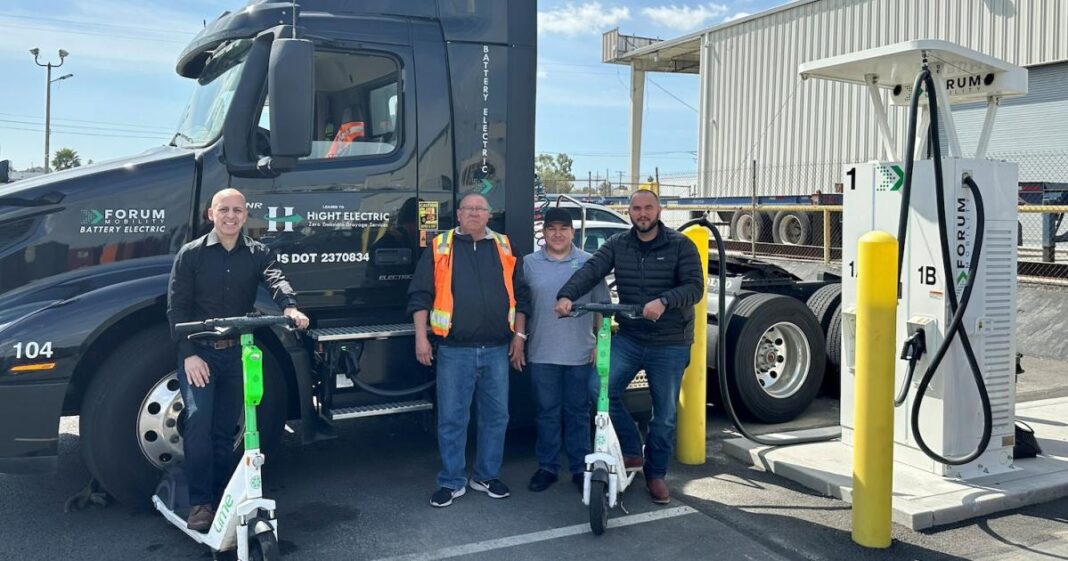Lime cut its greenhouse gas emissions 16.3 percent in 2023 by redesigning its electric scooters and bicycles and switching its operational fleet to electric trucks. Lime has made cumulative cuts in emissions of 30 percent since 2019, according to the company’s latest “carbon inventory.”
At the same time, the company grew bookings for its rented vehicles 32 percent to $616 million and turned a profit of close to $100 million.
San Francisco-based Lime disclosed two sets of goals that are validated by the Science Based Targets initiative for emissions reductions by 2030:
- It wants a 90 percent cut for Scope 1 and Scope 2 emissions, which include Lime’s operations and its footprint from electricity usage.
- For Scope 3, which includes the impact of the scooters and bicycles it rents, Lime is aiming for an 97 percent reduction in “carbon intensity” per passenger-kilometer. So far, it has managed a 59.5 percent cut.
A bigger, better battery
Lime attributes its progress to a four-year redesign of its vehicles, according to Andrew Savage, the Lime co-founder who has led sustainability strategy since 2019.
Close to 90 percent of the scooters in Lime’s 200,000-plus-vehicle shared fleet (that overall number also includes bikes) have now been switched to a new “modular” design, which allows larger batteries to be swapped in and out of bikes and scooters.
The new battery is twice the size of the previous model. That means scooters can travel farther before their batteries need to be swapped, which translates into greater rider availability and longer trips. At the same time, the format reduces maintenance. Emissions from Lime’s purchased goods and services, including spare parts, account for 40 percent of its Scope 3 total.
“With our first carbon inventory, which was in 2019, it was quite clear that we needed to focus on three major things: our hardware, our operations and then logistics,” he said.
Lime’s sustainability council meets every quarter
The design change was supervised by a council of two dozen Lime staffers tasked with embedding sustainability into Lime’s business objectives. This group includes C-suite representatives for operations, supply chain, procurement, hardware engineering and logistics, Savage said.
“Sustainability sits right alongside profitability,” Savage said. “In many ways, we’ve seen them sort of have a very mutual benefit between the two.”
“The council is designed to ferret out barriers to charging forward as fast as we can on delivering on our carbon goals,” he said.
Lime calculates its scooters have so far replaced 135 million car trips and saved 24 million liters of gasoline. That translates into 54 million kilograms of carbon dioxide avoided by riders, the company said.
Next up: A 100% electric operational fleet
The next wave of emissions reductions will build on Lime’s decision to electrify its operational fleet — the trucks, vans, and tricycles it uses to collect and deliver bikes and scooters. Close to 70 percent of the fleet, about 192 vehicles, is now electric. That’s shy of its 100 percent goal by the end of 2023, primarily because Lime has had challenges finding logistics service providers at its European hub that use electrified equipment, Savage said.
The fleet is used to handle repairs, rebalance the supply of scooters and bikes between drop-off and pick-up locations, and to shuttle spare parts throughout the 280 cities where Lime operates.
Electricity capacity at warehouses and in shipping ports has been one obstacle in the transition, but a new partnership with two California companies that provide shipping and electric truck logistics will accelerate the progress, according to Savage.
In that deal, all Lime freight arriving in Los Angeles and Long Beach is now transported to depots via heavy-duty electric trucks. The deal covers half of Lime’s incoming U.S. shipments, or about 300 containers. Lime doesn’t own the fleet: The loads are hauled by 20 electric trucks managed by Hight Logistics, a family-owned company that transports goods arriving by sea to nearby distribution hubs.
These short-haul “drayage” routes are usually less than 100 miles from an air or ocean freight terminal. There are more than 20,000 trucks registered for access to the port of Los Angeles. Fewer than 300 were electric, as of May 2024.

Electrifying drayage makes sense, but cost is steep
Electric tractor-trailers can cost three to four times more than diesel models — at up to $400,000. They also with load constraints, said Lance MacNiven, national lead for zero-emissions vehicle and fleet planning with consulting company WSP. This is a challenge for the business models of privately owned companies, he said. “As a truck operator, you’ve drawn the shortest straw here,” he said.
But contracts with clients like Lime can influence investment into electric vehicles for drayage, sources said.
“The real power at this moment is with cargo owners that are signing these contracts every year,” said Ricky Parker, who manages the EV 100 program for Climate Group in North America. More than 120 companies have committed to electrifying their fleets by 2030, as part of the EV 100 campaign.
It cost “millions of dollars” for Hight to go electric, including the expense of the trucks, the charging stations to serve them (a turnkey service it contracts from Forum Mobility), and salaries for full-time drivers, said Hight CEO Rudy Diaz. His company charges competitive rates and calculates emissions avoided for its customers, he said.
“Lime took a big leap of faith in doing this,” Diaz said. “They are one of the first.”
More companies are gathering information, given California’s push to phase out new diesel trucks by 2040 and concerns over air pollution in communities around big logistics centers, but few have committed to a transition plan, he said.
